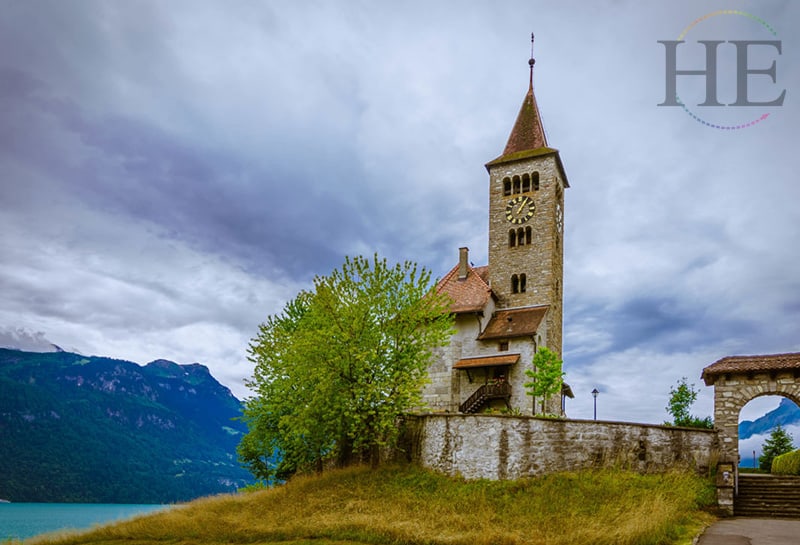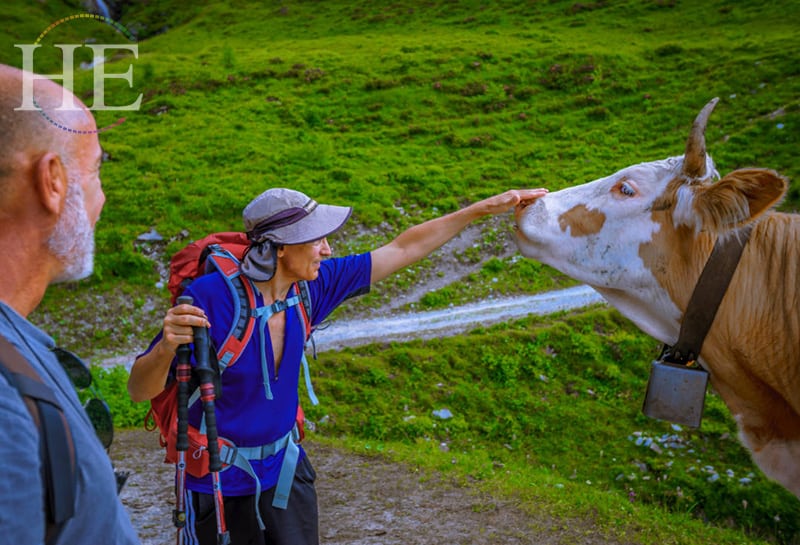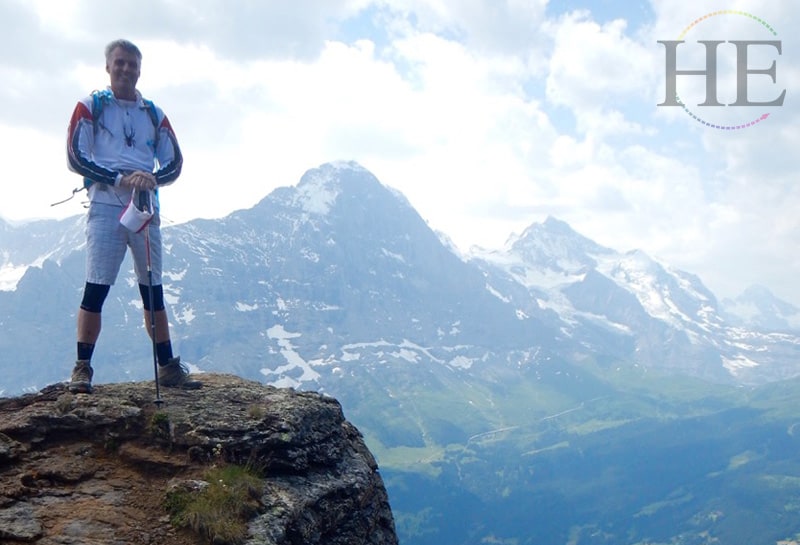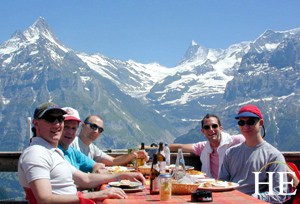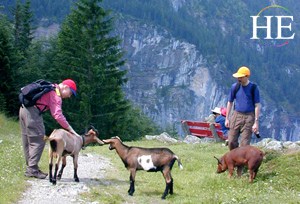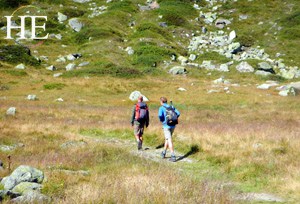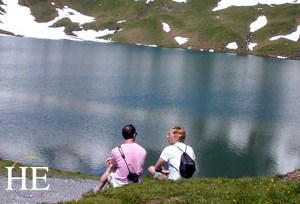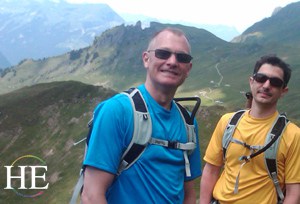Grindelwald: Gay Switzerland Hiking Tour
Gay Travel Switzerland Tour
Prices listed are per person:
Shared Room: $5698 (couples only - 1 bed)
Private Room: $7098
Three impressive Alpine peaks — the Eiger, Moench, and Jungfrau — rise abruptly from the river valley in the central Alps on this gay Swiss hiking tour. During our week of hiking, these “Oberland Giants” form a constant backdrop to the shining green meadows and breathtaking cliffside paths.
Highlights
Hike a high and wild path along the base of the giant Nordwand (North Wall) of the Eiger, nemesis of innumerable mountaineers.
Stand at the edge of the 6500-foot high lake at Bachalpsee, with the Jungfrau reflected in the silvery surface.
Listen to the cracking of a glacier as you hike above it to lunch at a remote mountain restaurant.
Take a train through a mountain to Jungfraujoch, the highest train station in Europe, then walk through an art museum where each piece on display is carved from the ice inside the glacier.
Or take a break from hiking for an optional tandem paraglider ride or a mountain biking day, ascending a mountain by lift or by pedal-power, then coasting back down, past waterfalls and fields of wildflowers.
Overview
A picturesque alpine village offers the perfect base for our hiking week.
The Swiss Alps were made for hiking, and no region of Switzerland offers a more picturesque setting than the Bernese Oberland. Our hiking trip is set deep in this mountain valley, in the centuries-old village of Grindelwald. To the south rise some of the best-known alpine peaks: The Eiger, Moench, and Jungfrau, and three glaciers. Unfolding more gently to the north are the meadows of wildflowers, forests, and mountain lakes that have made Switzerland such a favorite with calendar illustrators.
We’ll hike into both of these alpine worlds, walking along the base of the intimidating Eiger North Wall, near frosty glaciers, and through acres of green pastures dotted with brown cows and inquisitive goats.
Itinerary
Map:
The schedule below relates to a typical week. Our actual sequence of hikes may change based on weather and other conditions. And, of course, you always have the choice of trying a different itinerary, alone or with new friends.
Day 1: Arrival
The tour begins with a scenic train ride to transfer from the airport to our chalet. Switzerland’s rail system is among the best in the world: fast, comfortable, and efficient. As you pass the picturesque lakeside town of Thun, you may resolve to return to this pretty medieval town after your week of hiking.
Changing trains at Interlaken, you’ll see other hikers and climbers, the former easily recognized by the hiking poles that nearly all Europeans seem to favor; the latter by the ice axes strapped to their bulging backpacks. Grindelwald is the end of the line, and as you step out onto the town’s lively main street after several hours on trains, one breath of mountain air will quickly revive you.
Our hiking trip begins with an orientation, followed by dinner, and time to meet a fun group of gay hikers.
Day 2: Above the Glacier
Today’s hike will take us across a glacial river and past an abandoned marble quarry (once a source of jobs and income for the town) to arrive just outside Grindelwald. We will continue along an alpine trail above the icy crevasses of the “Lower Glacier.” Soon we’re hiking well above the glacier, with changing views of the icy mass below.
Lunch today is at a remote mountain restaurant that serves a surprisingly sophisticated menu for its unique location. After lunch, we will hike farther bringing us not only closer to the glacier but to Schreckhorn, a 4078-meter peak. Hardier hikers might get to the Schreckhorn hut before turning back.
Our final stop is at Gletscherschlucht, the narrow gorge whose vertical walls were carved into the rock by the churning waters of the glacier. A narrow boardwalk, jutting out from the cliff face, gives us a close-up look at the sculpted canyon and rushing waters below.
Day 3: Reflections in a Mountain Lake
This morning most of us will probably choose to ride the lift up the north slopes, to a spot named “First”. But a few energetic souls may elect to hike up and meet us there.
First, we hike along an easy trail to the blue mountain lake known as the Bachalpsee. A magnificent green pasture filled with cows, and bells tinkling, extends down toward the valley floor. On a calm day, the distant snow-capped peaks reflect in the lake’s waters. Then the trail thins out, twisting beside a spiny ridge, past moonlike rock formations. Descending past a cascading waterfall, we pass a lush patch of wildflowers and easily count a dozen varieties within an arm’s reach: red, yellow, blue, purple, white, pink, and lavender.

You may want to stop for a late lunch at the mountain inn of Bussalp. Here, hikers again have a choice: to descend by foot, or on one of the ubiquitous yellow “Post Buses” that serve so many small Swiss hamlets such as this one.
Day 4: New Perspectives
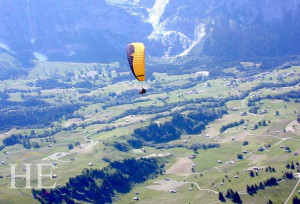
Today there are several enticing options to try!
- Paraglide over the mountain trails gaining a new perspective on Grindelwald valley. No paragliding experience is necessary: You’ll fly tandem with an experienced, licensed pilot.
- Take the train to nearby Thun. A delightful medieval city on a blue lake, dominated by an imposing castle. Toot across the lake on an old steamer then hike along the shoreline.
- An easy day trip. Take a train or boat to Brienz, a charming Swiss town whose artisans are known for their violins and wood-carvings, then ride Switzerland’s only surviving steam-powered cog railroad to the mile-and-a-half high Rothorn (one of our favorite train rides!).
- Spend time down the valley in Interlaken for urban life and shopping.
- Or check out these mountains on a bike! This would be a good day to rent a mountain bike, take it up a lift, and then ride down to the village (verrrrry carefully!).
Day 5: The Top of Europe
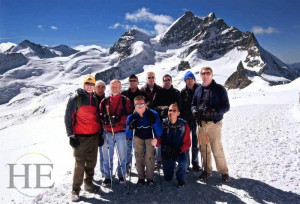
Today we will ride the Jungfrau cog rail train to Europe’s highest railroad station (3454 meters) on the massive Jungfrau mountain. The journey will take us over deep ravines and through mountain tunnels carved inside the Eiger and Monch. From here you’ll enjoy views of the Aletsch glacier, the longest in Europe. Roam the Ice Palace, carved into the blue glacier and decorated year-round with intricate ice sculptures; enjoy a run of summer skiing, or slide down the slopes on a snow disc.
Continue hiking part of the way back on the recently-opened Eiger trail right under the Nordwand (North Wall) of the Eiger, a vertiginous cliff that has defeated many a mountaineer. We won’t try any mountaineering ascents today, just a scenic hike, crossing the narrow, twisted gorges of glacier-fed streams, then winding through the forest, until we emerge over (but on the other side of) the “Lower Glacier”.
Day 6: A Waterfall Inside a Mountain
Today’s suggested itinerary begins with a train ride to Lauterbrunnen, a picturesque village set in a cleft between two towering cliffs. Waterfalls spout out along either side, as we walk to Trummelbach Falls. Here, every second, glacier-fed streams pour up to 5,000 gallons of water down a series of ten waterfalls.
We will return back to the village where you can select one of the local cafes for lunch. After lunch, we will hike 930 vertical meters up a switch-backing path from Wengen to Mannlichen. Some of us will want to hike all the segments and others may want to take the cable car part of the way.
From Mannlichen, you can ride a mountain cable car right back to Grindelwald, but we hope you won’t: The high alpine trail over to Kleine Scheidegg is among everyone’s favorites. Gently descending as it passes around cliffs and peaks, this trail offers an ever-changing panorama of the mountains: The Eiger, the Monch, and the Jungfrau.
Day 7: Marmot World, or a High Plateau
The Swiss alpine peaks have provided magnificent scenery for us this week. On our last day, we wanted to cater to those more serious hikers. The Schynige Plateau offers one glorious option, and the Schwarzhorn offers a more challenging day. If your choice is for a lighter day the narrow-gauge Schynige Platte Cog Railroad engine chugs up to the Schynige Plateau for viewing a high ledge with a panoramic view of the imposing 15-kilometer-long Bernese Oberland wall.
For our serious hikers, this is an invigorating full day of hiking. Portions of the trail follow a narrow ridge, dropping to views of the Eiger on the right, and to the placid blue waters of Lake Brienz on the left.
For those looking for a greater challenge, the jagged peak of Schwarzhorn, on a high crest to the north of Grindelwald, is accessible by several trails, some easier, some rougher. Hiking all the way there from Grindelwald makes for a full day.
As we descend, the trail takes us along an area popular with marmots, and again we enjoy a break while watching these gregarious, bushy-tailed creatures.
Day 8: Departure
Our hiking week officially ends this morning. If you have early connections, you can depart as early as you’d like. Or you may want to pack up, store your bags, then squeeze in one last hike.
If you’ve got extra vacation time to spend in Europe, we suggest you save it for after the trip, rather than before: chances are that others in the group will welcome company as they explore the culture and gay life in Geneva, Zurich, Berne, or other Swiss cities.
Price Includes
Price includes: 7 nights lodging in a shared or single room, with a private bathroom; 6-day pass that covers MOST Jungfrau-area trains, buses, and lifts, including the Jungfraujoch train; Welcome packet; All breakfasts, four lunches, and two dinners; HE Travel provides complimentary Medical & Evacuation Insurance for every US Resident on our group tours who does not have other coverage.
Not included: Transportation to and from Grindelwald (easily accessible by train); Meals not listed here; Optional activities, such as mountain biking and paragliding; Personal expenses such as laundry, telephone charges, alcohol (except when provided with a meal), and gratuities for guides and HE Travel tour director.
Extensions
Stay longer and join our
The Matterhorn is a constant yet ever-changing presence in the alpine village of Zermatt. One day coyly hiding behind the clouds, the next, a proud white pyramid against a blue sky.
Our gay hiking trip in Switzerland introduces travelers to the beauty of the Valais region surrounding Zermatt, often going far and high into the alps on all-day hikes. Our group will stay in the lovely mountain village of Zermatt, just a few hours’ travel from Geneva or Milan, yet a world apart. Each day, you can join a larger group on a hike, or head out independently. Most people find it enjoyable to stay with the main group some days and to hike more independently, with one or two friends, a few times.
We’ll spend one night at a mountain lodge, allowing us to reach some remote locations that would be inaccessible on a single day’s hike.
When you take two tours Back-to-back, you get a discount! Contact us for details.
Tour Insurance
We strongly recommend the purchase of Trip Cancellation and Interruption insurance to protect your vacation investment in case of unforeseen circumstances such as flight delay, illness, or injury. Click Here to learn more about our Insurance partner.
FAQ
The most direct way to get there is to fly into Zurich, Geneva, or Milan, then connect by train. But many other European cities also have convenient connections. If you want to visit Paris, Munich or Berlin, for example, you may choose to fly into one of those cities instead.
Mountain weather anywhere tends to be unpredictable, and the Bernese Oberlands are no exception. This is a moister climate than, for example, the Zermatt region. That’s why the pastures are so green, and the wildflowers so lush! Some years we have had only a few hours of rain during our entire week around Grindelwald, and a t-shirt will often be all you need. However, it’s quite possible we’ll have a day or two of rain, and you should always carry a sweater and light waterproof top.
If you are not doing additional travel within Switzerland, we recommend the Swiss Card (not to be confused with the Swiss Pass), which will (as of this writing -- subject, but not likely, to change), get you from your entry point (the Swiss border, or any airport in Switzerland) to most destinations (including Zermatt and Grindelwald), and back; it also gives you a 50% discount on most additional travel in Switzerland, including some of the lifts and railroads from Zermatt and Grindelwald. You can find out more about various passes from RailEurope. But please remember: We never promised that this was simple.
However, the more popular hiking trails in the Alps are generally well marked, with clear signs that indicate distances in walking hours (Std.=stunde, German for hour.) Yellow signs mark a wanderweg, a relatively easy trail. The more difficult Bergwegs (mountain trails) are marked with white-red-white blazes at the top. These may involve scrambling over rocks occasionally, or narrow trails that occasionally wind near a vertical drop.
Swiss trails occasionally cross onto private property. You’re welcome to hike here, but close the gates after you, to keep the sheep or cows in. You’ll see signs that say, Bitte die Tur Schliessen, which means Please close the gate.
Some fences are electrified. You’ll see the telltale plastic or glass insulators. Gates on such fences have plastic latches for you to use.

